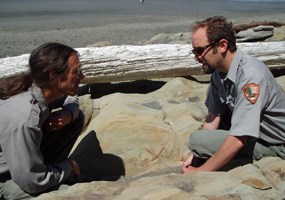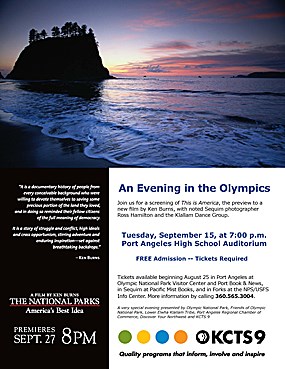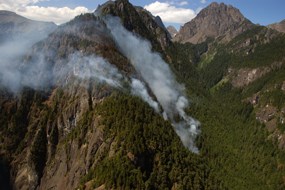
Ancient Sea Star Discovered on Olympic Coast On what seemed to be an ordinary day at Kalaloch, one lucky visitor made an extraordinary find. Embedded in a sandstone bluff on Beach Four was a fossilized sea star, the likes of which have never before been seen on the Olympic coast. “It’s very unusual,” said Gay Hunter, Olympic National Park’s museum curator. “Once it’s studied we’ll know a lot more.” The visitor used a cell phone to take a picture of the fossil, and showed it to Interpreter Pat Shields, who in turn alerted other park staff. Curators at the University of Washington’s Burke Museum and the Denver Museum of Nature and Science were then contacted for advice. They responded with enthusiasm, advising that the fossil be excavated from its site for safe long-term storage and study. In the words of one paleontologist, “This is indeed fabulous and beautiful and so amazingly unusual.” The sea star was removed from the beach about two weeks later, on July 16. On the advice of museum experts, park staff used a diamond-bladed rock saw to cut it from the rock, a six-hour process that was gingerly undertaken to protect the fragile fossil. The project piqued the interest of numerous passersby, and an interpreter was part of the team to help explain the process to Kalaloch visitors. “It was a little unnerving,” said Olympic National Park Coastal Ecologist Steve Fradkin, who headed the excavation project. “I’ve never actually used a rock saw to remove a fossil before.” Initial analysis of the sea star puts it at somewhere between 5 and 24 million years old. While the taxonomy is not apparent, the turbidite formation it was found in suggests it was a denizen of the deep seas. It was likely preserved in sediment by an underwater avalanche and like the peninsula’s numerous other marine sediments, was later uplifted to form the Olympic Peninsula. The sea star was sent to the Burke Museum, where it will be studied and put on display along with a discussion of the importance of national parks in preserving fossil resources. Fradkin, however, says that park visitors are just as vital to paleontology as the park itself. “These fossils are out there,” he said. “If a vigilant visitor hadn’t noticed it, we would never have found it.” -- Matthew Connolly, Intern 

Olympic National Park to Host "An Evening in the Olympics" On Tuesday, September 15, Olympic National Park will host “An Evening in the Olympics,” beginning at 7 p.m. in the Port Angeles High School auditorium. The event will feature a screening of “The National Parks: This is America,” an introduction to the new Ken Burns documentary about the national parks, as well as a performance by the Klallam Dance Group and a presentation by noted Sequim photographer Ross Hamilton. Burns’ documentary, “The National Parks: America’s Best Idea,” tracks the history of the national park system, from its roots in the 1800s to its founding in 1916 to visitor experiences today. The film will present the national parks through the eyes of a diverse group of individuals and comment on the system’s place in the fabric of the country. The area that is now Olympic National Park first came under federal protection when President Grover Cleveland designated most of the Olympic Peninsula's forested land as the Olympic Forest Reserve in 1897. President Theodore Roosevelt enhanced this by designating part of the reserve as Mount Olympus National Monument in 1909, in large part to protect the native herds of Roosevelt elk. President Franklin D. Roosevelt signed legislation establishing Olympic as a national park in 1938, cementing its status as a protected area for a diverse array of plants and wildlife. More information about America's Best Idea --Matthew Connolly, Intern 
Heatwave Complex Fires Burn in Olympic Wilderness Lightning ignited twelve fires in Olympic National Park during June and July, five of which are still active. These fires are collectively referred to as the Heatwave Complex; none of them pose any immediate threat to life, safety and property and are benefitting the natural ecosystem. The 628-acre Ten Mile fire continues to burn in the Duckabush area, while the 438-acre Constance fire continues to burn slowly in the Dosewallips region The east side of the Constance fire is being confined to prevent spread to Olympic National Forest and the Dosewallips Ranger Station. The 324-acre Buckinghorse fire and the 140-acre Knife fire continue to smolder and creep in the upper Elwha Valley. Smoke has not been visible on the four-acre Sol Duc fire in the Seven Lakes basin for several days. Firefighters continue to monitor these naturally-occurring and slow-moving fires, and are prepared to take action as needed. Naturally caused wildfires have occurred in the Olympic Peninsula for thousands of years, and are an integral part of the area’s ecosystem. As they burn, these slow-moving fires create a diverse mosaic of forest canopy and fire-induced open land, providing a rich variety of habitat for the park’s plants and animals. Additional information on the Heatwave Complex fires can be found at InciWeb. Visitation Update Recreation visitation for the year is up 11 percent compared to the first seven months of 2008. For more information, and monthly visitor use updates, check the National Park Service NPS Stats website. |
Last updated: January 12, 2018
